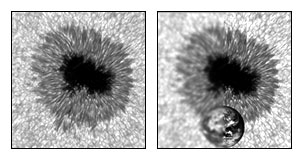SUNSPOT, N.M., Oct. 17 -- Advanced technologies now available at the National Science Foundation's (NSF) Dunn Solar Telescope at Sunspot, N.M., are revealing striking details inside sunspots and hint at features remaining to be discovered in solar activity.
This image, spanning an area more than three times wider than Earth, was made possible by the Dunn's recently completed AO76 advanced adaptive optics image-correction system and a new high-resolution CCD camera. The Association of Universities for Research in Astronomy operates the Dunn as part of the National Solar Observatory under a cooperative agreement with the NSF.

This ultrasharp image of sunspot AR 10810 shows several objects of current scientific interest. G-band bright points, which indicate the presence of small-scale magnetic flux tubes, are seen near the sunspot and between several granules (columns of hot gas circulating upward). Above left: High-resolution image of sunspot produced with the new camera attached to the Dunn's adaptive optics system. Right: In this version, a NASA image of Earth is added for scale, and both Earth and sunspots are artificially blurred on the left half to simulate normal, uncorrected view through Earth's atmosphere. (Photos: Friedrich Woeger, KIS, and Chris Berst and Mark Komsa, NSO/AURA/NSF)
The dark cores of penumbral fibrils and bright penumbral grains are seen as well in the sunspot penumbra (the fluted structures radiating outward from the spot). These features hold the key to understanding the magnetic structure of sunspots and can only be seen in ultra high-resolution images such as this one. Magnetism in solar activity is the "dark energy problem" being tackled in solar physics today.
Normally such features are beyond the grasp of ground-based solar telescopes because of blurring by Earth's turbulent atmosphere. The Dunn's AO76 system compensates for much of that blurring by reshaping a deformable mirror 130 times a second to match changes in the atmosphere and refocuses incoming light. This allows the Dunn to operate at its diffraction limit (theoretical best) of 0.14 arc-second resolution, rather than the 1.0 to 0.5 arc-second resolution normally allowed by Earth's atmosphere.
The Dunn has two high-order adaptive optics benches, the only telescope in the world with two systems, which enhances instrument setup and operations.
This image was built from a series of 80 images, each 1/100th of a second long (10 ms), taken over a period of 3 seconds by a high-resolution Dalsa 4M30 CCD camera in its first observing run after being added to the Dunn. Speckle imaging reconstruction then compiles the 80 images and greatly reduces residual seeing aberrations.
The camera is part of the equipment suite for the Dunn's diffraction-limited spectropolarimeter, which is designed to analyze magnetic field strength and direction inside sunspots.
The Dunn and its new systems are available for the world solar physics community to use.
For more information, visit: www.sunspot.noao.edu